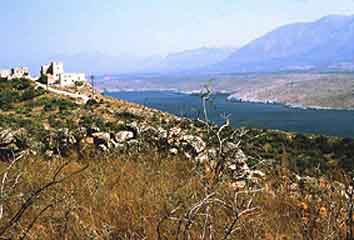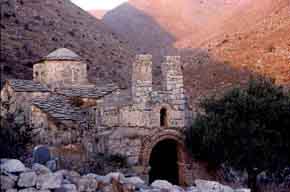
Since I wrote this website with the excerpts from Greenhalgh and Eliopolos, a new Mani-Website by John Chapman has appeared in the internet (2005). It far surpasses my own little attempts and any other extant guide.
Chapman's website is much to large to copy, even in parts, here is its URL
John Chapman, Mani Guide and History
THE BYZANTINE CHURCHES OF THE MANI
(most are in dilapidated condition)
from: Peter Greenhalgh and Edward Eliopoulos "Deep into Mani" (Faber & Faber, London 1985)
The Deep, Inner Mani
Pýrgos to Kitta (West Coast)
Glézos, Aghios Mikhail 11-th cent. E. of road, unmarked dirt-road 200-m S. of Pyrgos, road ends after 500 m, Ag. Mikh. visible in graveyard + cypresses. 5-min walk
Triandafiliá, Aghios Pétros 11-th cent. W. of road, 1200-m from Pyrgos, (ruined megalithic church of Aghios Sotiros at sharp corner on the way to village) Agh. Petros in village
Kharoúda, Aghios Mikhail** 11-th cent., church in operation. Cruciform. Marble architraves. Pastel-colored murals 18th/19th cent. - In graveyard with cypresses, continue to drive through Triandafilia
Tsópakas, Aghia Trissákia*** 9-th cent?, badly ruined. Three parallel naves. Extraordinary interior: 14-th cent murals. Last supper. Gethsemani. High-quality complete marble ikonostasis. - W. of road. Turn-off dirt road 5 km S. of Pyrgos, at first sharp turn park car, rough monopati to W. through open fields, olive groves, after >20 minutes walk, red-brown reservoir + church - Note: little white church near deep karst hole on drivable road is not Ag. Trissakia, gone too far!
Kafíona, Agh. Theodoros** 12-th cent. 13-th cent murals. Unusual Transubstantiation and Re-embodiment. W.-side
Kouloúmi, Aghios Mikhail 12-th cent. restored 19-th cent, murals whitewashed
Érimos, Aghia Varvára* Fine example architectural cruciform, 12-th cent?. In bad repair. W-side. Turn-off main road at Lakkos few hundred meters megalithic church, from there walk to visible belfry+dome
Vámvaka, Agh. Theodoros**, Dated 1075. Cruciform. Notable carved 11-th cent.marbles by Nikitas. Ikonostasis with fable animals. Murals white-washed. E-side of main road on old eastern, higher road.
Bríki, Agh. Nikolaos** + 3 others in ruins. Village E-side. Aghios Nikolaos unspoiled with fine 14-th cent murals. 1 km south of Vamvaka
Mina. E-side tower village. From here rough monopati 20 km cross mountains to east-side (not recommended!)
Tourlotí, Aghii Sergios+Bakkhos** Restored 12-th cent. Good cloisonné masonery. Few good murals preserved. Last Supper, archaic style. Built by one Georgios Marasiates from Maras (in Kilikia!) north of Aleppo (Armenian?) which explains the Syrian saints! 1 km north of Kitta.

Kitta, Many towers
Kitta-Kalloní, Aghii Asómati** Early 10-th cent. Cruciform with three apses and octogonal dome (Armenia? Georgia?) in a gorge, under mountain saddle (about 600 m) between Mt. Pelagía and Mt. Asómati above, an overgrown oasis of fig trees (spring?). - "Stiff climb" starts from Kalloni, tiny cluster of towers east, above Kitta.
.
The Cavo Grosso

Mézapos, Historic town, not much today :
Aghia Kiriaki: Drive: W.-side road, 2-km south of Kitta to Psion and Stavrí. From Stavri track W. to Aghia Kiriaki (750 m) Shown in photo left.
From there a 2-km hike across the pan-handle to Tigáni***, fabulous location on isolated, white peninsula in the blue sea: ruins of sea-castle of Villehardouin(?) incl. foundations of its church. On the way there small church Aghia Kiriaki, a pre-9th-cent. (6-th cent?) church, Cyclopian walls (12-th cent. BC?).
Aghios Prokopios**, Early 9th-cent. Ruined heap of stones. Inside: traces of iconoclastic paintings (first half of 9-th century)! On foot from Episkopi? in direction of Stavri, church visible 500 m W. of Episkopi, South of Ag. Kiriaki.
Aghia Odighítria, 13-th cent. cruciform. Murals: 18-th cent.: Gliofilousá. 13-th cent.: Ascension+ Christ carrying cross, Archangel Mikhail. Overhangs the sea in steep sea-wall. Ask and walk from Aghia Kiriaki. Overlooking Mezopos bay from south. Take road to Stavri-Aghia Kiriaki (see above) but 1.5 km from main road turn right to Aghios Georgios 2 tall deserted towers: Kolóspita. Stony monopati between towers descends between stone walls. Keep left and around corner, 100 m emerge above the church of:
Aghii Episkopi*** 12-th cent. Well preserved and documented (Murals***: Last Judgement on ceiling!) Old marble architrave but 18-th cent painted ikonostasis. Panaghia Platytéra in apse repainted in 18-th cent? All other murals 12-th cent. Life of Aghios Georgios. Story of feast of Aghios Theopistos of Kappadokia(!) as shown antedates the written records of the story in the Ambrosiana text (14-th cent.)!
Vlakhérna, 12-th century. Ruined church. No murals visible. But under magnificent oaks in graveyard. Beautiful view. - Directly below the two towers, on overgrown track 15-minutes, midway between towers and the sea.
Gardenítsa - Aghios Sotíros, Early 11-th cent. Architectural: early distyle cruciform. Kufic? letters in wall. Domed porch. Just off main road to Kitta, between Mezapos turn-off and Aghios Georghios
Kéria, Aghios Ioánnis, 13-th cent. Tetra-style cruciform. Over one dozen, exceptional, large ancient marble reliefs in outer wall taken from earlier buildings. - Hard to find tiny hamlet between Okhiá and Koúnos, not to be confused with Dri!
Okhiá, Aghios Nikolaos 12-th cent. Gargoyles. Setting in evening light. - 1 km south of Keria. Church + campanile (1861) stands by itself in open country. - 1 km due by car from church then on foot: great south-facing cliffs with superb view over the sea.
Gerolimenas, ("Sacred Harbor") new village, no towers, harbor, 2 "hotels" Giali: beach. windmills, stone church, romantic Mantoúvali tower.

Ano Boulari, Aghios Strátigos*** 12-th cent. Well documented rich mural program of 12-th cent. in entry narthex and 13/14-th cent. eastern half and apsis. Many eastern martyrs: Armenian, Syrian, Persian! in a 12-th cent Byzantine church?! e.g. Gregory of Armenia and Gregory the Great - Key with police in Gerolimin or priest in village of Élia. Cornelius' "snake church", shown at left
Ano Boulari, Aghios Pantaleïmon***, an early 10-th cent. two apse-church in Mani. No dome. Slate covered roof. Remarkable early murals (inscription-dated 991). Monopati NW at bridge above modern church of Dormition past threshing grounds, a megalithic church, after 500 m under olives single stone hut: Panteleïmon.
The Southern End: Akron Taínaron and the East Coast
|
|
Álika- northern road to Láyia - zig-zags up pass- 4km -Tsikaliá - view of Váthia - about 4 km from Tsikalia watch for turn-off south (about 3 km before Layia): red earth track 3 km to Korogoniánika (or Korogiánika) with great southern VIEW onto Porto Káyio - little working church at cemetery with faded 10-th cent.(?) murals - road dead-ends.

Alika- southern road - Vátheia - go south to Kyparissos (Pausanias: remnants of Demeter and Aphrodite temples, foundations of St. Peter 6th-cent church) - difficult road south along west-facing rock wall - Pirgi (two ruined watch-towers) - road turns east above Porto Marmari (ancient Akhíllion) - isthmus -Porto Kayio ((picture above, Venetian: Porto Quaglio) (castle and monastery in cypresses and gardens, water fountain!) - short track to a cemetery on isthmus - end of drivable road - ardent hike south to site of once famous Poseidon temple at ancient Tenaron (nothing left) but silly cave-hole to the underworld not worth the effort !
Alika - steep but well asphalted road (soon after Alika off northern road to Layia) to Moundanistíka 650 m high above Layia (telepohne station!). Moundanistika (haunted towers - but incomperable VIEW) - possible: difficult hike of 5 hrs (snakes) down to Layia.
Alika - northern road - Tsikalia - Láyia (several fine towers) - Eastern Coast - Kokkala - Flomokhori - Kotronas – Areópolis
The East Coast
14-km of inner Tibet! - only fresh-water spring in ravine 3 km NW. and high above Kokkála:
Kournós, Monastery of the Dormition, Half-ruined, 17-th cent.(?) monastery surrounded by luxuriant trees at top end of Kournos ravine, 3 km W of Kokkala. To get there continue road from Kokkala 5 km north , turn off road to village of Nimfi. When road ends walk >2 hours(!) - go very early - across steep sea-facing hillside of Kournós ravine to Moni. No monks, only peasant family. Excellent water! - 500 m further and still higher up site of two Doric temples locally known as Kiónia ("the Columns") - One oval(!) 9.2 by 8.4 m peristyle the other rectangular 7.2 by 5.1 m with two columns in antis. Magnificent site! - Remnants of a third temple and an extensive settlement larger than today's remnants of old Tenaron. No name, no dates, no dedication known - hellenistic(?), after Pausanias' time (end of 2-nd or 3-rd cent AD?)
Flomokhóri, Water, prosperous village. High towers.
Kótronas, delightful fishing village, with fine view, sandy beach, island of Skota
Skoutári, sandy beach, deserted monastery Agh. Georgios
Loudákia, castro
Pírrikhos, Pausanias: well in market, Artemis temple, invasion and battle of Amazons repulsed
Areopolis - Total travel 150 km.
The Outer Mani
Spilio Dirou, popular cave, ride boats on extended underground waterways
Platsa, is a traditional settlement of the Messenian Mani, with many defensive towers, harmonically combined with the exceptional natural setting. Several more significant churches are to be seen in the village: St. Paraskevi, a cross-vaulted church with wall paintings of the 15th century, the Byzantine church of St. Demetrios and a few post-Byzantine churches. Church of St. Nicholas at Platsa, The church is a three-aisled basilica built in the 10th century. The dome was added in the mid-14th century by Constantinos Spanis and at the same time the interior was decorated with wall paintings representing two different styles. A votive inscription is preserved in the middle aisle, and other inscriptions are seen among the decorative elements of the walls. The wall paintings of the north aisle date to the 15th century. Sculptures of the Middle Byzantine period are preserved in the iconostasis. The roof of the church has been retiled, the surrounding buildings have been restored, and the wall paintings have been supported and cleaned. Today the church functions only once a year.